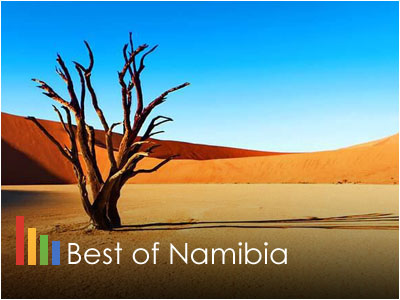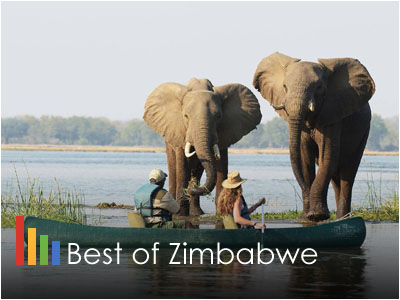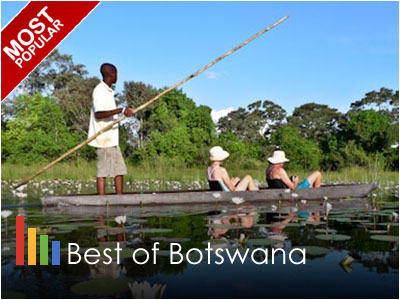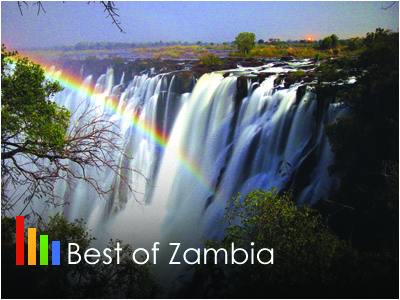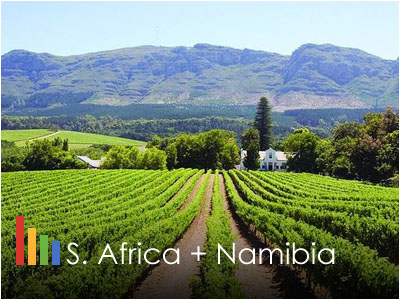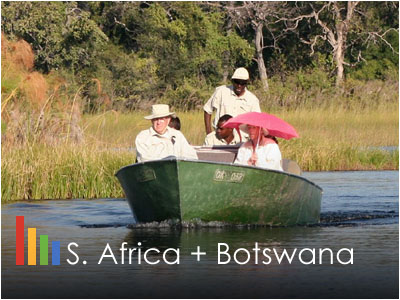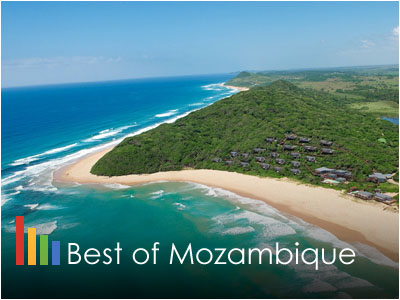Destination Botswana, Africa
Botswana - Africa's best-kept secret!
Botswana is Africa's best-kept secret. Experience the stunning beauty, the unimaginable vastness, the isolation and worldliness, the astoundingly prolific wildlife. Botswana is a premier Southern African safari destination offering some of the best wildlife viewing on the planet, especially in and around the Chobe and Okavango Delta region. The Kalahari Desert with its San Bushman culture is another Botswanan highlight that deserves a place on your itinerary. Ranging from endangered animals such as wild dogs and rhinos to the numerous and thriving bird life that inhabits the area. The natural landscapes are impressive too from the vast and imposing Kalahari Desert to the sublime serenity of the Okavango Delta. The terrain here can feel vast and empty in some areas or dense and teeming with life in others but it is always a thing of beauty. The landscape is at once recognizable as African and will live up to all of your pre-trip expectations.

Botswana - Basic Facts
Botswana, officially the Republic of Botswana is a landlocked country in Southern Africa. At 581,730 km2 (224,607 sq mi) Botswana is the world's 48th-largest country. It is similar in size to Madagascar or France. Botswana adopted its new name after becoming independent within the Commonwealth on 30 September 1966. Since then, it has been a representative republic, with a consistent record of uninterrupted democratic elections and the best perceived corruption ranking in Africa since at least 1998. It is currently Africa's oldest continuous democracy. Botswana is topographically flat, with up to 70 percent of its territory being the Kalahari Desert. It is bordered by South Africa to the south and southeast, Namibia to the west and north, and Zimbabwe to the northeast. Its border with Zambia to the north near Kazungula is poorly defined but is, at most, a few hundred metres long. Botswana has diverse areas of wildlife habitat. In addition to the delta and desert areas, there are grasslands and savannas, where blue wildebeest, antelopes, and other mammals and birds are found. Northern Botswana has one of the few remaining large populations of the endangered African wild dog. Chobe National Park, found in the Chobe District, has the world's largest concentration of African elephants. The park covers about 11,000 km2 (4,247 sq mi) and supports about 350 species of birds.
About Botswana - from Okavango Delta to Kalahari Desert
Botswana is a wild and unspoiled country, home of the famous Kalahari desert, as well as grasslands, savannahs and the capital city of Gaborone. There is also the largest inland delta in the world, the Okavango, and a wealth of wildlife to discover. Although this landlocked African country is home to some uniquely beautiful landscapes (including brilliant red sand dunes and the world’s largest salt pans) it’s all about the wildlife. Botswana is filled with sprawling open savannahs which teem with migrating mammals and their predators but it’s less visited destination than some of its African rivals, offering a much more natural safari experience. Botswana is a premier Southern African safari destination offering some of the best wildlife viewing on the planet, especially in and around the Chobe and Okavango Delta region. The Kalahari Desert with its San Bushman culture is another Botswanan highlight that deserves a place on your itinerary. From a lush river delta to a peaceful rhino sanctuary here’s our pick of Top 10 most popular destinations in Botswana;
Botswana Famous Cities, Towns and Villages
Gaborone: The city of Gaborone is the largest in Botswana and also its capital. The modern buildings of Gaborone set against the tropical backdrops of this African nation are an unusual sight and despite its size, there are not too many reasons to visit the city. The large residential areas are supplemented by a few decent hotels and restaurants. The modern feel of the city is reinforced by its lack of history but it is certainly paving the way for the countries future and for this reason it is a good place to experience the vibe of 21st Century Botswana.
Francistown: The oldest town in Botswana is the second largest in the country. Francistown was built on gold mining before Europeans came and looked to prosper from it themselves. In fact the town takes its name from a British man; Daniel Francis. The main sights in the town include the Supa Ngwao Museum which documents the life and culture of the Kalanga people through various exhibits. There is also a refuge for orphaned wild animals called Birds and Game Botswana. The town is currently experiencing an economic boom due to the recent resurgence of gold mining.
Kasane: Kasane is situated between the Four Corners of Africa; where Botswana, Zimbabwe, Namibia and Zamibia meet. It is a great spot to stay for visits to the Victoria Falls in Zimbabwe or Botswana’s own Chobe National Park. The town’s own attractions include a huge Baobab tree that was once used as a prison due to its trunk that is so large a human can enter. There is also a snake park that houses around 50 snakes from 17 different species. The town is also wonderfully situated for exploring the Chobe River.
Maun: Maun is often used by tourists as a stepping stone for the Okavango Delta but it has enough about it to merit a few nights stay. The hotels, restaurants and tourist amenities here are some of the best in the country, largely due to the fact that the city is the main tourist stop in the country. Whilst the town itself does not have much going for it, it still attracts a wide range of people from luxury safari travelers to volounteers. There are some great campsites that are located by the river, providing a great place to stay for a few nights.
Gabane: This village is not far from Gaborone and is a great location for exploring the hills on foot. The village is surprisingly industrious and houses a number of small manufacturers such as glassworks, metal and pottery on the aptly named Pelegano Village Industry. The pottery factory in Gabane is particularly worth a visit due to its shop selling wares such as crockery, vases and other handcrafted decorative items. The most popular reason for visiting the village however is the great location for hiking.
The Okavango Delta
The Okavango Delta is one of the most inspiring and awe-inspiring wilderness locations in Africa, if not the entire planet. The Delta is a truely unspoiled wilderness with terrain ranging from dry grasslands to swamps. Safaris and game watching are the most popular activities in the park and possible animals to be sighted include cheetahs, zebra, giraffes, elephants, crocodiles and rhinos to name only a few. Trips should be properly planned because, although the terrain here is always stunning, the seasons can dramatically effect your chances of seeing certain animals. Described as the ‘river which never fnds the sea’ and ‘the jewel of the Kalahari’, the Okavango Delta is a huge expanse of water in northern Botswana, which has travelled from the Angolan highlands, spreading out to form the largest inland river delta in the world. Studded with exotic islands and reed banks, the Delta is renowned for its incredible variety of bird life and animals including elephant, lion, leopard, buffalo, zebra, giraffe, wildebeest, hippo and crocodile, amongst others. The best way to see the delta is by mokoro, traditionally a canoe dug out from a large tree, today a more environmentally friendly version. Relax and take in the beautiful scenery and wildlife, whilst your poler navigates the maze of waterways. The swamps and surrounding area can be navigated in a 4x4.
Moremi Game Reserve
Voted the best game reserve in the African continent in 2008, this park has a lot going for it. It is the first reserve that was solely founded by local residents who were growing ever more concerened about natural and man-made threats to the local enviroment and wildlife. Situated on the east side of the Okavango Delta, the reserve offers some of the most stunning scenery in the country and boasts an equally impressive ecosystem. Many tourists choose to visit the park by self-drive campervan but the park also has a number of great campsites. Moremi Game Reserve covers some 4,871 km² (70% of which is part of the Okavango Delta) and is considered one of the most beautiful wildlife reserves in Africa as it combines mopane woodland and acacia forests, lily covered wetlands, flood plains and lagoons. Moremi consists of a network of waterways surrounding two large islands - Chiefs Island in the west and Mopane Tongue in the east. In this pristine wilderness area birdlife is prolific and varied, with over 500 species ranging from water birds to forest dwellers. There are many species of ducks, geese and heron as well. As Moremi is a fenced reserve, game viewing is impressive throughout the year. Elephants are numerous, particularly during the dry season, as well as buffalo, giraffe, lion, leopard, cheetah, wild dog, hyena, jackal and the full range of antelope.
Chobe National Park
Chobe National Park is the second largest park in Botswana and covers an area of 10,566 km². With areas of marshland, flood plains, savannah, grasslands, woodland and the Chobe and Savuti Rivers, the park is wonderfully diverse. Chobe has one of the greatest concentrations of game found on the African continent and is known for its elephant population, with some 120,000 based in the park. The elephants tend to be very large but their ivory is brittle, so they only have short tusks. As well as elephant, an abundance of giraffe, zebra, impala, sable, wildebeest, kudu, waterbuck, warthogs, eland, lion and hyena can be seen, and if you are very lucky, cheetah and leopard. In the northern areas near Kasane, game viewing on a Chobe Sunset River Cruise is a particular highlight. The Savuti area is in the south west of Chobe National Park, just above the Okavango Delta and covers 5000 km². Referred to as ‘The Kingdom of the Lion’ due to the high density of lions in the area, Savuti is renowned for its prime game viewing with an abundance of wildlife, both predators and prey.
Central Kalahari Game Reserve
The Central Kalahari Game Reserve is a staggering 52,800km² making it the second largest game reserve in the world. The striking landscape is characterised by shimmering salt pans, semi arid grassland, fossilized river valleys and bushveld. The reserve has a diverse range of wildlife including vast herds of antelope and its legendary black maned lions. In summer thousands of animals graze on the flourishing plains and the rains cause magnificent dust clouds. Four fossilized rivers run through the reserve, including the beautiful Deception Valley, which is one of the best areas for game viewing. As one of the world’s most uninhabited regions (with under a 1,000 residents, most of which are the hunter-gatherer Bushmen who have inhabited the Kalahari for 30,000 years), you can game drive all day and not bump into another soul. Wild, mysterious and amazingly vast, the Central Kalahari Game Reserve is a true wilderness that will give you the impression that you are exploring Africa alone. Incredible grasslands engulf you by day whilst the skies at night are as clear as the clearest in the world. The rain in summer brings about countless wild beasts of all shapes and sizes including massive herds of animals like wildebeast and springbok. Without so many animals in the harsher winter months, the main reason to visit the Central Kalahari Game Resrve is the unfathomable open terrain and true African wilderness.
One notable feature of the Kalahari are the Tsodilo Hills. The Tsodilo Hills appear almost suddenly out of the ground in the northwest Kalahari. These imposing rock formations of varying shapes and sizes are made to love even more impressive by the relative flatness of the surrounding land in the Kalahari. Nicknamed the ‘Louvre of the Desert’, the Tsodilo Hills are covered in over 4,500 cave paintings created thousands of years ago. The hills have been declared a UNESCO site due to their fascinating history, and for the Sans people that have lived here for over 30,000 years with their drawings dating back as early as 500 AD. Botswana is a fairly flat country with the Tsodolio Hills rising dramatically out from the western Khalari Desert. It’s an incredible sight especially when the rock face turns a bright copper colour with the setting sun. The area is of huge spiritual significance to the people who live here. As you spend the day here and follow the trails, coming across the rock paintings along the way, you’ll see the history of the Sans people and their interaction with animals n front of your own very eyes.
Makgadikgadi & Nxai Pan National Park
The lesser-known Makgadikgadi and Nxai Pan National Park is a vast area that includes Ntwetwe Pan, Kudiakam Pan, Nxai Pan and Makgadikgadi Pan, which is the largest of them all. These salt pans are all that remain of an ancient great central Botswana lake that covered the Kalahari several million years ago. In the dry season the plains of the national park are barren. Animals gather to drink and resident hippos wallow in the deep pools of water, which are all that remain of the dried up Boteti River. At this time of year the never-ending ethereal lunar landscape of glistening salt pans is spectacular and quad biking is popular. When the rains come, a dramatic change is seen as the area springs to life - grasslands flourish and the pans fill up with water, attracting a fantastic array of waterbirds and triggering spectacular migrations of wildebeest and zebra. The name may be a mouthful but the reasons to visit Makgadikgadi Pans National Park are simple. The park stretches from the Boteti River and for this reason supports a vast and diverse ecosystem. The wildlife is particularly varied in the dry season when animals come from miles around to the river which is the only source of water for a long way.
Tuli Block
The Tuli Block is located in the easternmost corner of Botswana, where the Limpopo and Shashe Rivers meet and integrates the Mashatu Game Reserve, Tuli Nature Reserve and other smaller game reserves. It is an area of diverse and compelling beauty, with rocky outcrops, riverine forests, giant baobab trees and open savannah plains, which are a haven for the largest single population of elephants on private land. This unspoilt wilderness is also home to giraffe, wildebeest, kudu and zebra, and predators such as cheetah, leopard and hyena but the main attraction is the rare black-maned lion. The history of the area dates back an amazing 80 million years, with several interesting Stone Age sites, wonderful African Rock Art on the Tswapong and Lepokole hills and curious geographical rock formations such as Solomon’s Wall.
Kgalagadi Transfrontier Park
The Kgalagadi Transfrontier Park is an immense wilderness, a mesmerising desert landscape of pans, towering red dunes and fossil river valleys. Covering 38,000km across both South Africa and Botswana, with the majority over Botswana, in 1999 the two countries came together to work for the protection of the wildlife creating the world’s first Transfrontier Park. The park is home to large herds of springbok, gemsbok, meerkats and wildebeest, all hunted by the predators of lions, leopards, hyenas and cheetahs. It’s in fact one of the best places in Botswana to see the famous fast cat. Despite the wealth of animals, due to its remote location in the north of Botswana and being slightly removed from the major routes, the park receives only a small number of visitors.
Linyanti Wetlands
In the northeast of Chobe National Park, the Linyanti River forms a swamp area similar to that of the Okavango Delta but on a much smaller scale. For those who make the journey to this hard-to-reach corner of Botswana, they’ll be rewarded with a safari that feels almost exclusive due to the lack of people and 4x4 vehicles heading out each day to discover what wildlife the endless vistas holds. The wetlands are home to three private concessions with the swamps, open grasslands and riverine forests holding a diverse range of fauna. The area is perfect for canoe safaris. Huge herds of elephants and buffalo congregate along the river alongside large concentrations of lion, hippo and antelope and if you’re lucky even the odd wild dog and leopard.
Savuti National Park
Savuti is famous for its mysterious Savuti Channel which flows and subsides seemingly with no relation to rainfall. Stretching for 100km from the Chobe River, it was dry for over 70 years after 1880 before flooding again in 1957. The intriguing landscape and ecology supports what is known as one of Africa’s best game hotspots, with a high density of predators. Any safari here is wild, remote and full of exceptional wildlife spotting whilst being immersed in one of Botswana’s most beautiful areas. It’s here you can also see one of Africa’s incredible migrations as thousands of zebras make the journey to the Savuti for the lush grass during November and December. As with many other national parks, the dry season is a wonderful time to spot the huge prides of lions hunting their prey collecting around the shrinking waterholes. For more information regarding Botswana Holiday Travel ideas, DO NOT hesitate to Contact Us.
AfriChoice operates a wide range of carefully designed tours and safaris to Botswana by providing transport and booking a hotel for you. Our safari consultants will always be at your assistance should you need a tailor-made holiday to this unique destination. NB: For more information regarding Botswana Travel, DO NOT hesitate to Contact Us.
Contact Us for more information:
Our Top Southern Africa Trips
-
Best of South Africa
South Africa's Best Spots
-
Best of Namibia Safari
Explore Namib Desert & More!
-
Best of Zimbabwe Safari
Explore Mana Pools and Beyond
-
Best of Botswana Safari
Discover Okavango Delta & Beyond
-
Best of Zambia Safari
Discover Zambia's Secrets
-
S. Africa & Namibia
From Winelands to Namib Desert
-
South Africa & Botswana
From Kruger to Okavango Delta
-
Mozambique Private Locations
Mozambique's Hidden Spots
Other POPULAR Safari Destinations! Explore Our Safari Destinations - EAST AFRICA and BEYOND!
-
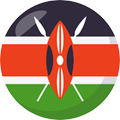
Kenya
KENYA - Traditionally known as the true home of African Safari & Beach Holidays. -

Tanzania
TANZANIA - The land of Kilimanjaro, Serengeti National Park and Zanzibar Islands. -

Uganda
UGANDA - Popular for the Gorilla Tracking Adventures and the source of River Nile. -
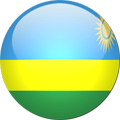
Rwanda
RWANDA - Emerging safari destination also know for it Mountain Gorillas and more. 
Indian Ocean
AFRICAN BEACHES - Know for its Turquise Blue waters and the pristine sandy beaches.-
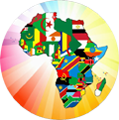
Others
OTHER DESTINATIONS - We also offer trips to holidays to other African countries of interest.



 Paul Kitching - UK
Paul Kitching - UK Karen Howard - CANADA
Karen Howard - CANADA



